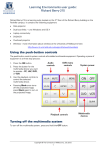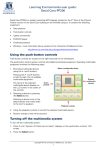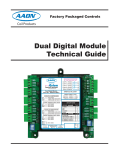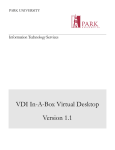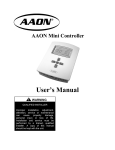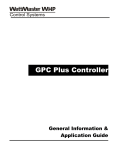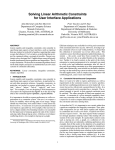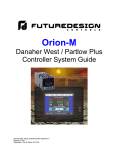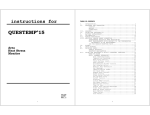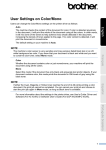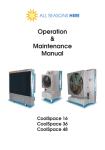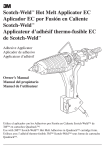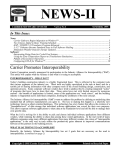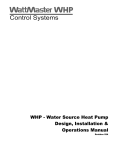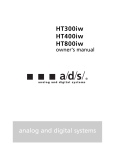Download Specifications
Transcript
6SHFLILFDWLRQV This document is subject to change without notice. WattMaster Controls, Inc. assumes no responsibility for errors, or omissions herein. 8500 NW River Park Drive Parkville, MO 64152 Website: www.orioncontrols.com Tool Free Phone: 866-918-1100 Phone: 816-505-1100 Fax: 816-505-1101 E-mail: [email protected] Orion Control Systems Product Specifications - Form OR-ALL-SPC-01B Copyright 2002 WattMaster Controls, Inc. All rights reserved. Control system shall be AAON factory mounted controllers with the Orion System. Control system shall be a microprocessor based digital system. All system devices shall be low voltage – 24 VAC. All controllers must be capable of operating in a true Peer-To-Peer mode without using any other intermediate panels for transferring data between controllers. The supplier must be willing to demonstrate that two or more controllers can exchange data such as temperatures, pressures, humidity, etc without using an intermediate panel to accomplish this transfer. The use of intermediate panels, which can produce “bottlenecks” and reduce or restrict the flow of data within the system and add substantial cost to the system, shall not be allowed. Controllers shall be factory mounted by HVAC equipment manufacturer. Controllers shall be available for the following HVAC applications: - Make-up Air Units. High percentage outside air rooftop unit’s w/automatic heating & cooling changeover. Variable Air Volume VAV Box Control Single Zone Constant Volume Zoning Zone Damper Control HVAC unit controllers shall be capable of operation in the following configurations: - Stand alone - Interconnected - Networked Stand-alone operation is defined as: - Controller can function independent of any other devices. - Controller can be programmed and monitored without requiring a PC. - Controller can be controlled by a conventional thermostat without the need of additional interface devices. Interconnected operation is defined as: - Up to 59 controllers can be interconnected via a two wire shielded communication loop. - All controllers can be programmed and monitored from a central location without requiring a PC. - Communication loop shall be capable of accepting a central connection for a PC and/or modem for on site and/or remote monitoring. Networked is defined as: - All control devices in the system are interconnected via a communication loop back to a central PC and/or modem. - Networked systems shall also be capable of having one or more non-PC central operator’s panel that can communicate with all unit controllers in the system from central locations. - Network systems shall always include Windows based, graphical PC software. System communications shall be an RS-485, HSI Open Protocol, Token Passing network. All communication wiring shall be a minimum shielded 18 gauge twisted pair. Cable shall be plenum rated. If VAV boxes or Zone dampers are present in the system, all VAV and Zone controllers shall utilize a modular wiring system. This system shall consist of one or more power and communications distribution panel. The power and communications distribution panels shall receive a connection from the communications network and a separate 24 VAC power connection sized to accommodate all control devices connected and possible voltage drops. All power and communications shall be connected to VAV and Zone controllers by modular type connectors. No screw terminal connections will be allowed. Page 1 All unit controllers shall be microprocessor based with onboard time clock and calendar functions. In the event of a power failure, the controller shall retain all programmed values in non-volatile memory for a minimum of 10 days without the use of a battery. In the event of power failure, controllers shall restart in a staged fashion in order to prohibit all equipment from starting simultaneously. Depending on the capability of the HVAC equipment, unit controllers shall be capable of the performing the following if applicable: - Control up to 8 stages of cooling Control up to 8 stages of heating Field selectable control sensor (i.e. Room, Discharge, Outside Air, Return, etc.) Fan proving interlock Drybulb or Dewpoint economizer control (unit must be capable of calculating actual Dewpoint) Building relief pressure control De-humidification Control Control of hot gas reheat IAQ economizer control with CO2 sensor 7 day / 2 events per day time of day scheduling internal to each controller 14 day holiday scheduling internal to each controller Optimal start internal to controller Trend logging internal to controller Supply air reset capability (based on Room, Outside Air, or VFD) External override capability for occupied/unoccupied and mode selection For all VAV and Zone Control applications, controller shall provide an analog output signal to operate a VFD for static pressure control. An analog input signal shall also be provided for a static pressure signal. If VAV or Zone Damper control is present, one controller shall be field configurable for VAV and Zone control applications. All controllers shall be microprocessor based and monitor space temperature to allocate proper airflow into its zone to achieve the desired comfort and ventilation levels. Both pressure dependent and independent control shall be possible from the same controller. The controller shall be powered by 24 VAC and shall utilize pre-wired modular connectors for all wiring connections. Damper actuator, airflow sensor (Pressure Independent only), and auxiliary relay board wiring, shall be performed using modular, plug-in connectors. Auxiliary relay boards shall be provided if control of baseboard heat, box heat, series fan, or parallel fan control is required. VAV Box Controller shall provide inputs for the following: - Room Sensor Room Sensor Setpoint Adjustment Unoccupied override button Zone Damper Actuator Feedback Signal Air Flow Sensor (Pressure Independent Only) Optional Supply Air Sensor VAV Box Controller shall provide outputs for the following: - VAV Damper Actuator (Modulating) - Auxiliary Relay Board Expansion: - Baseboard Heat - Electric Heat - Hot Water Valve (Modulating) - Series Fan - Parallel Fan Page 2 The VAV Box controller will provide the following control functions: - Occupied/Unoccupied - Heating/Cooling Setpoints - Min/Max Zone Damper Position (Pressure Dependent) - Min/Max Zone Damper CFM (Pressure Independent) - Override Operation - Room Sensor Setpoint Adjustment Range - Room Sensor Calibration Offset - Auxiliary Heat Setpoint - Trend Logging Interval The following status values from the VAV Box controller shall be accessible from the operators interface panel: - Room Temperature - Cooling & Heating Setpoint - Room Sensor Setpoint Adjustment Value - Heating/Cooling Demand - Zone Damper Position (True Feedback) - Airflow (Pressure Independent Only) - Current Damper Min/Max - Position/Airflow Setpoints - Current Duct Supply Temperature - Current HVAC unit Mode of Operation - Relay Expansion Board Status (If connected) - Force Mode Status - Calibration Status - Override Status - Alarm Status - Software Version Installed The following alarm values from the VAV Box controller shall be accessible from the operators interface panel: - Damper Calibration Failure - Damper Drive Open Failure - Damper Drive Close Failure - Zone Sensor Failure - Missing Zone - Zone Temperature out of Setpoint Range for over 1 Hour VAV Dampers The VAV Box controller shall be capable of factory or field mounting on any VAV box manufacturer’s unit that uses a damper with a rotating shaft. Damper Actuators All VAV box damper actuators shall be direct coupled type with a minimum running torque of 35 in-lb. Actuators shall be a tri-state/floating type with true position feedback. Actuators shall be rated for a minimum of two million cycles. Rotation shall be 90 degrees with a running time of 90 seconds. Actuators shall be powered by 24 VAC. All wiring terminations, power, control, & feedback shall be made through a single modular plug connector. Actuator shall include an override clutch mechanism for manual adjustment. Page 3 Zone Dampers, if present, shall be available in round or rectangular types. Zone Damper controller shall provide the same control capability and features as listed above for the VAV controllers. (Pressure Independent not available in rectangular dampers). Round dampers: - Sizes available shall be 6 – 16 inch in two inch increments. - Controller and actuator shall be factory mounted. - Low leakage design – less than 1% at 3” WC. - Damper shall be fully insulated in fiberglass wrap insulation. - Bronze blade bushings – plastic will not be accepted. - Damper should be ARI Certified. Rectangular Damper: - Flange mounting – slide in designs not acceptable. - Manufactured from extruded aluminum. - Opposed blades. - Blade and jamb seals. - Airfoil design blades. Room Room sensors shall be a flush mount, tamper resistant design, using an industry standard, Type III, 10K thermistor. Sensor accuracy shall be plus or minus 0.4 degrees Fahrenheit. Sensor shall be protected in such a way that internal wall temperature variances will not effect the sensor reading. Sensor shall be housed in an offwhite, plastic enclosure. Sensor shall be available in four different configurations: - Sensor Only - Sensor with Override Button - Sensor with Setpoint Adjustment - Sensor with Override & Setpoint Adjustment Duct & Outside Air Sensors Duct and Outside Air sensors shall be industry standard, Type III, 10K thermistor. Sensor accuracy shall be plus or minus 0.4 degrees Fahrenheit. Duct sensors shall be a probe type with a minimum 8” length. Outside Air sensors shall be mounted in a weather protective enclosure and shall be mounted outside in a location where the sensor will not be affected by direct sunlight. Outdoor Air Humidity Sensor The relative humidity transmitter shall be a solid state device that converts the relative humidity (0-100%) into a 4-20 mA signal, with a minimum accuracy of plus or minus 3%. CO2 Sensor for IAQ The CO2 sensor shall be designed for monitoring CO2 levels and have the capability for wall mounting in the required space or duct mounting in return air duct. The duct mounted sensor shall include an aspiration box with a probe that samples air from the return air stream. Sensors shall use the dual beam Absorption Infrared technology. This sensor shall be accurate and stable and be guaranteed to maintain its accuracy for a minimum of 5 years between calibrations. The CO2 Sensor’s accuracy shall be ± 50 PPM @1000 PPM. Annual drift shall not exceed 10 PPM per year. Repeatability shall be ±20 PPM. Page 4 A central operator’s panel shall be provided. All HVAC controllers connected to the network shall be accessed from one operator’s panel. All system values and setpoints shall be accessible for viewing and modification through this interface panel. The interface shall consist of a membrane keypad for the purpose of data entry. Interface panel shall have function keys to assist in ease of programming. The operator interface shall have a 4 line by 20 character, backlighted, LCD display for the purpose of displaying system status, values, setpoints, alarms, and error messages. The display shall be menu driven and must show data with English descriptors. Special code or cryptic messages will not be acceptable. Interface must provide password protection to protect data from non-authorized users. A portable handheld service tool shall be provided. The portable service tool shall be capable programming, monitoring, and commissioning all HVAC controllers. The service tool shall consist of a membrane keypad for the purpose of data entry. The service tool shall have function keys to assist in ease of programming. Service tool shall also include special function keys for the purpose of field configuration of controllers and software functions to assist in air balancing of VAV and Zoning systems. Service tool shall be provided with a dual power source - battery power and a plug-in 110/24 VAC transformer. An interface device shall be provided to allow both a computer and modem connection to the system. The interface shall provide two serial port connections for connection to PC and modem. The interface shall also provide auto-dial out capability to a remote PC and auto-dial out to a pager when alarm conditions occur in the control system. Both local and remote PC’s may be active simultaneously. A Windows based, color graphics software package shall be provided to the end user, even if local or remote communications with a PC is not implemented with the initial installation of this system. Software shall be compatible with Microsoft Windows 95 / 98 / ME. DOS or OS/2 operating systems will not be acceptable. A full functioning licensed copy of the software with a user manual shall be included along with a copy of the software. The software shall not be copy protected as to restrict its installation on multiple computers. Software shall not require an external hardware key or device in order to operate. The software shall provide the following features and functions: - Preprogrammed Status Screens Menu Driven, Fill in the blank Programming for all system values & setpoints User definable, English language descriptors for all controller locations User friendly setup for on site or remote communications Multiple Levels of Password Protection Alarm Auto-dial out to a pager Alarm Auto-dial out to a remote PC Remote connection setup for multiple building sites Custom Graphics Editor Trend Log Setup Automatic Trend Log Retrieval Download of Trend Logs to CVS Format for importing into spreadsheets Fill in the Blank Schedule Programming Point & Click Programming of Holiday Schedules Automatic Air Balance Force Modes Diagnostic Counters Alarm Logging User Access Logging Page 5 !" All system components shall be covered by a 3 year parts warranty with the exception of humidity and CO2 sensors, which shall be covered, by a 1 year parts warranty. Page 6 Form: OR-ALL-SPC-01B Printed in the USA March 2002 All rights reserved Copyright 2002 WattMaster Controls Inc. • 8500 NW River Park Drive • Parkville, Mo. • 64152 Phone (816) 505-1100 www.orion.com Fax (816) 505-1101












